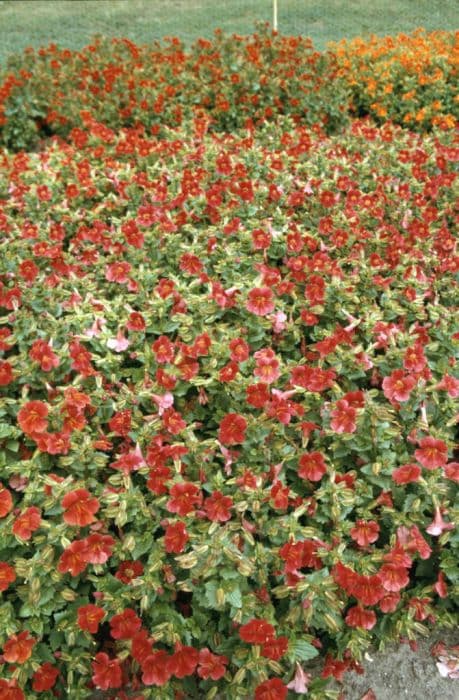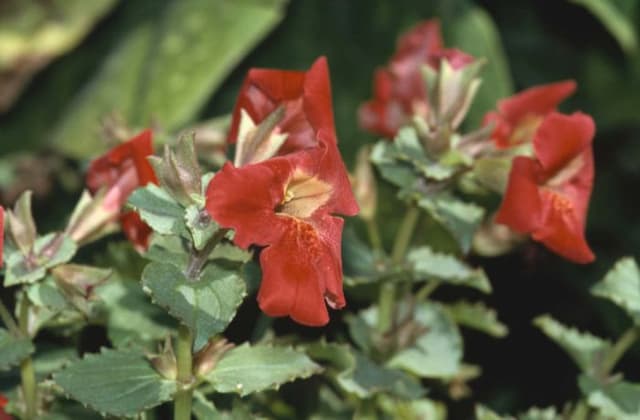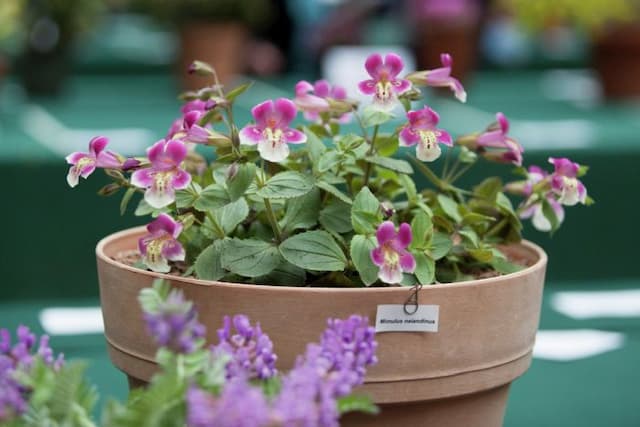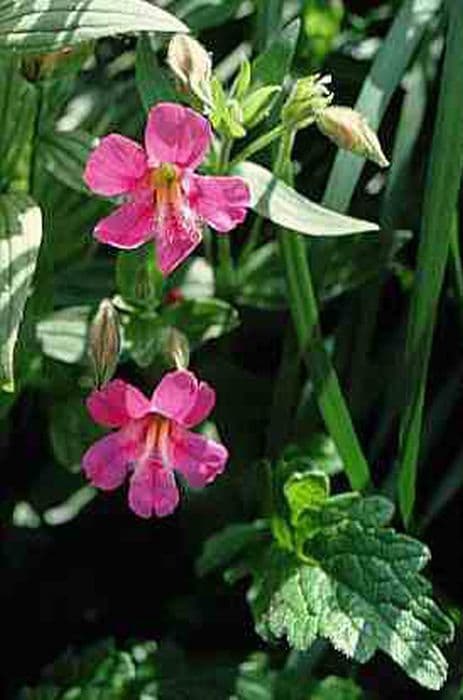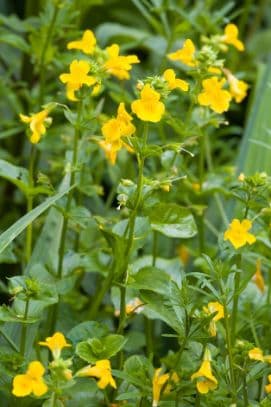Monkeyflower Mimulus aurantiacus

ABOUT
Mimulus aurantiacus, commonly known as the sticky monkey flower, is a vibrant perennial plant. Its most striking feature is the profusion of tubular flowers, which possess a vivid orange hue with lighter or darker shades occasionally present. These flowers are substantial and showy, drawing the attention of humans, as well as hummingbirds and other pollinators. The plant's foliage consists of evergreen leaves that have a sticky texture and are typically a rich green color. These leaves can be oval or lance-shaped and may have margins that are toothed or somewhat wavy. The sticky monkey flower has a shrubby form, with a branching structure that supports its floral display. Its stems can appear somewhat woody as the plant matures. Overall, it presents a bushy appearance that can add both greenery and a burst of color to the landscape. This plant is well-adapted to sunny, dry conditions and is an important component of its native habitats, which include coastal zones and lowland areas with Mediterranean-like climates.
About this plant
 Names
NamesSynonyms
Sticky Monkey-Flower, Orange Bush Monkey-Flower, Monkeyflower
Common names
Diplacus aurantiacus, Diplacus glutinosus, Mimulus glutinosus.
 Toxicity
ToxicityTo humans
Sticky Monkeyflower is not commonly known to be toxic to humans. There is little to no reputable information suggesting adverse effects from ingesting this plant. However, as with any non-food plant, it is generally recommended that people do not consume parts of it due to the potential for allergic reactions or unknown compounds that may be harmful. Always consult a medical professional or a poison control center if ingestion occurs.
To pets
Sticky Monkeyflower is not widely recognized as a toxic plant to pets. There is limited information available regarding its effects on animals if ingested. As a precaution, it is usually advised to prevent pets from consuming non-food plants, including Sticky Monkeyflower, to avoid the risk of gastrointestinal upset or potential allergic reactions. If you suspect your pet has ingested any part of this plant, it is best to consult with a veterinarian.
 Characteristics
CharacteristicsLife cycle
Perennials
Foliage type
Evergreen
Color of leaves
Green
Flower color
Orange
Height
2-4 feet (0.6-1.2 meters)
Spread
2-4 feet (0.6-1.2 meters)
Plant type
Shrub
Hardiness zones
9
Native area
California
Benefits
 General Benefits
General Benefits- Attracts Pollinators: Mimulus aurantiacus, commonly known as Sticky Monkey Flower, attracts bees, butterflies, and hummingbirds, which are beneficial for pollination in gardens and natural ecosystems.
- Drought Tolerance: Sticky Monkey Flower is well adapted to dry conditions, making it an excellent choice for water-wise landscaping and xeriscaping.
- Low Maintenance: Once established, it requires minimal care, making it suitable for gardeners seeking low-maintenance plants.
- Erosion Control: The plant's root system helps stabilize soil on slopes and embankments, preventing erosion.
- Habitat Restoration: Sticky Monkey Flower is used in native planting schemes to restore and support local ecosystems and biodiversity.
- Aesthetic Appeal: With its vibrant orange flowers, it adds a splash of color to gardens and landscapes.
- Wildlife Food Source: Its nectar and flowers provide food for local wildlife, including birds and insects.
- Adaptability: It can thrive in a range of soil types, from sandy to loamy, as long as they are well-draining.
 Medical Properties
Medical PropertiesThis plant is not used for medical purposes.
 Air-purifying Qualities
Air-purifying QualitiesThis plant is not specifically known for air purifying qualities.
 Other Uses
Other Uses- Mimulus aurantiacus, commonly known as sticky monkeyflower, has been used in basket weaving due to the strength and flexibility of its stems.
- The vibrant flowers of the sticky monkeyflower can be used as a natural dye, imparting a subtle yellow or orange hue to fabrics.
- Certain Native American tribes have been known to use the sticky monkeyflower in ceremonial rituals as a symbol of fertility and protection.
- The ample nectar of sticky monkeyflower makes it an excellent plant for gardening enthusiasts looking to attract hummingbirds and butterflies to their garden.
- Due to its attractive appearance, sticky monkeyflower is often used in drought-tolerant landscaping, providing a splash of color with minimal water requirements.
- Sticky monkeyflower can be used in environmental education to illustrate the concept of plant adaptation to students, showcasing its resilience in dry conditions.
- When included in wildlife-friendly gardens, sticky monkeyflower provides essential habitat and food for native bees, supporting pollinator populations.
- The plant's seed capsules have been used in crafts and jewelry-making for their unique shape and texture after the flower has dried and fallen.
- Because of its dense growth habit, the sticky monkeyflower can be used for erosion control on slopes and banks, helping to stabilize soil and prevent runoff.
- Film and photography enthusiasts sometimes use the sticky monkeyflower as a vibrant foreground or backdrop in natural setting compositions due to its eye-catching color.
Interesting Facts
 Feng Shui
Feng ShuiThe Sticky Monkeyflower is not used in Feng Shui practice.
 Zodiac Sign Compitability
Zodiac Sign CompitabilityThe Sticky Monkeyflower is not used in astrology practice.
 Plant Symbolism
Plant Symbolism- Courage: Mimulus aurantiacus, commonly known as "Sticky Monkey-Flower," symbolizes courage due to its vibrant and bright flowers that can stand out in rocky and challenging environments, reminding us to be bold and brave in the face of adversity.
- Positivity: The sunny appearance of Sticky Monkey-Flower represents a positive attitude and the ability to remain cheerful and optimistic, even when times are tough.
- Adaptability: Due to its ability to thrive in various conditions, Sticky Monkey-Flower is a symbol of adaptability, inspiring us to adjust and be resilient in different life circumstances.
 Water
WaterThe Sticky Monkeyflower should be watered deeply but infrequently to mimic its natural dry summer conditions. In general, allow the top few inches of soil to dry out before watering again. This may mean watering once every 1-2 weeks, depending on the climate and weather conditions. When you do water, apply water slowly at the base of the plant until the soil is soaked to a depth of several inches. Over the course of a month, the plant might need approximately 1-2 gallons of water, less if there's sufficient rainfall or more during particularly hot and dry periods.
 Light
LightThe best lighting condition for the Sticky Monkeyflower is full sun to partial shade. An ideal spot would be one where it receives at least 6 hours of direct sunlight daily, with some shade during the hottest part of the day to protect it from intense, scorching heat. A location with morning sun and afternoon dappled light would be excellent for promoting healthy growth and flowering.
 Temperature
TemperatureThe Sticky Monkeyflower flourishes best in temperate conditions and can generally withstand temperatures ranging from around 25°F in the winter to over 90°F in the summer. Ideally, maintaining an environment where the temperature stays between 55°F and 75°F will support robust growth. It is resilient but may need protection from frost in zones where temperatures drop below its minimum tolerance.
 Pruning
PruningPruning the Sticky Monkeyflower is beneficial for maintaining a bushy, compact shape and encouraging more blooms. Pruning should be done after the flowering season, typically in late summer or early fall. Remove dead or spent blossoms and cut back by about a third of the plant's size to promote new growth. Pruning may also be necessary to remove any damaged or diseased stems to keep the plant healthy.
 Cleaning
CleaningAs needed
 Soil
SoilStick Monkeyflower thrives in well-draining soil with a mix of 2 parts loam, 1 part sand or perlite, and 1 part peat or organic compost. A slightly acidic to neutral pH of 6.0 to 7.0 is ideal for optimal growth.
 Repotting
RepottingStick Monkeyflower does not require frequent repotting; it is generally recommended to repot every 2-3 years, or when the plant has outgrown its current container.
 Humidity & Misting
Humidity & MistingStick Monkeyflower prefers moderate to high humidity levels but is quite adaptable and can thrive in a range of humidity conditions common in outdoor settings.
 Suitable locations
Suitable locationsIndoor
Provide bright light, non-soggy soil.
Outdoor
Plant in well-drained soil, full to partial sun.
Hardiness zone
7-10 USDA
 Life cycle
Life cycleMimulus aurantiacus, commonly known as Sticky Monkeyflower, begins its life cycle with seed germination, which is typically prompted by warm temperatures and moisture. Seedlings establish themselves quickly, developing a small rosette of leaves at the soil's surface. Throughout the spring and early summer, the plant enters a vegetative stage, where it grows rapidly and produces lance-shaped leaves along branching stems. By late spring or early summer, the Sticky Monkeyflower blooms, displaying a multitude of tubular, orange to yellow flowers that are attractive to pollinators such as bees and hummingbirds. After pollination, the flowers develop into small, spherical capsules containing numerous tiny seeds. The plant completes its life cycle when these seeds are dispersed by wind or animals, and the plant may go dormant in response to hot, dry conditions, particularly in regions with a Mediterranean climate.
 Propogation
PropogationPropogation time
Spring-Early Summer
Mimulus aurantiacus, commonly known as sticky monkey-flower, is propagated most effectively through semi-hardwood cuttings. This method is typically carried out during the late summer to early fall when the plant's growth begins to slow and the stems are not as soft as they are in spring. To propagate, select a healthy, disease-free branch and cut a 4 to 6 inch (10 to 15 cm) length, making sure it has several leaf nodes. Strip the lower leaves and dip the cut end in rooting hormone to enhance root development. Then, place the cutting in a pot filled with a mixture of half peat and half perlite or sand to ensure good drainage. Water the cutting and place it in a warm, shaded area, providing a consistent moisture level until roots have developed, which usually takes about 3 to 4 weeks. Once rooted, the new plants can gradually be acclimatized to more sun before planting out.
